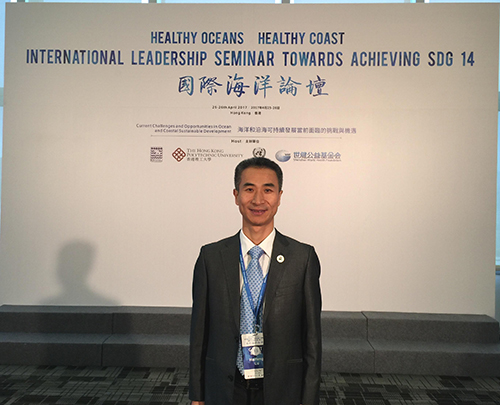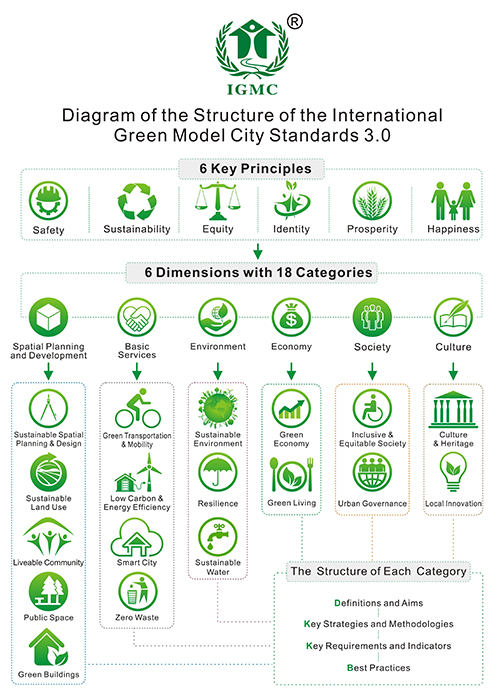


Committed to Sustainable Cities and Human Settlements for All

In Special Consultative Status with ECOSOC
Search
NameDescriptionContent
Home>>Text
Resilience in Coastal Cities and Human Settlements --Recommendations from International Green Model City Initiative
Source:
|
Author:gfhsforum
|
Published time: 2017-04-28
|
1597 Views
|
Share:
Lu Haifeng, Secretary General of Global Forum on Human Settlements
25-26 April, 2017 – Hong Kong, China
Keynote Speech
Delivered at
“Healthy Oceans – Healthy Coast”
International Leadership Conference towards achieving SDG 14
International Leadership Conference towards achieving SDG 14
“Current challenges and opportunities in ocean and coastal sustainable
development”
-Celebrating 45 years of IOI and its work in Sustainable Ocean Governance-

Global Context
The world is in large scale transition to Sustainability since 2015. SUSTAINABLE DEVELOPMENT GOAL 11 commits Make cities and human settlements inclusive,safe, resilient and sustainable.”SUSTAINABLE DEVELOPMENT GOAL 13 calls for “Take urgent action to combat climate change and its impacts.” SUSTAINABLE DEVELOPMENT GOAL 14 states “Conserve and sustainably use the oceans, seas and marine resources for sustainable development.” These 3 goals are closely related and inseparable. Definitely, Themed as Healthy Oceans-Healthy Coast, this gathering will contribute to the integrated implementation of these SUSTAINABLE DEVELOPMENT Goals.
Vulnerable Coastal Cites and Human Settlements
Coastal zones cover 20 percent of the earth space, where more than 45 percent of population live and work. By 025, about 75 percent of the world’s population could be living within 100 km of its coast. By the end of this century, 130 million people live within one meter of sea level.
Coastal cities are heavily vulnerable to natural isaster and are affected by rising sea levels led by climate change, increased precipitation, inland floods, more frequent and stronger storms, and periods of more extreme heat and cold. Nearly 80 per cent of disasters caused by natural hazards are weather or climate related. These hazards are likely to change in frequency, intensity, geographic range and duration as a result of projected changes in climate.
Let’s quote two miserable stories occurred in Asia coastal cities in the new century.The first is Indian Ocean Tsunami. In December 2004, the undersea megathrust earthquake triggered a series of devastating tsunamis along the coasts of most landmasses bordering the Indian Ocean, killing about 250,000 people in 14 countries. It was one of the deadliest natural disasters in ecorded history. Indonesia was the hardest-hit country, followed by Sri Lanka, India, and Thailand.
The Second is the Fukushima Daiichi Nuclear Disaster occurred on 11 March 2011. It was the most significant nuclear incident since April 26, 1986 the Chernobyl disaster. However, an estimated 1,600 deaths are elieved to have occurred due to the resultant evacuation conditions. Large areas of sea and land have been contaminated.Its adverse influence will last for many years.
Resilience
“Resilience is the capacity of individuals, communities, and ecosystems to prevent, absorb, accommodate and recover from a range of shocks and stresses which may be physical, social, or economic. A resilient system can continually survive, adapt and grow in the face of challenges and disturbances, which may be discrete and temporary, such as a natural disaster, or continue over a longer period, such as a shift in climate conditions or availability of key resources. Resilience includes both physical aspects such as infrastructure that provides protection from extreme weather events, and ‘soft’ aspects such as the social capital, knowledge, and financial support which can help communities respond quickly to disasters and adapt effectively to climatic changes[ UNEP and The Rockefeller Foundation, Urban Environmental Sustainability and Resilience, The New Urban Agenda]”.
Local governments should adopt and implement local disaster risk reduction strategies in line with the Sendai Framework for Disaster Risk Reduction 2015-2030.
(The graphic is about Resilience characteristics)

International Green Model City Initiative: Making Coastal Cities and Human Settlements Resilient
International Green Model City (IGMC) Initiative is a greener and low-carbon city development program initiated by the Global Forum on Human Settlements (GFHS) and greatly supported by the United Nations, of which the standards are advanced tool for directing and assessing low-carbon and resilient urban planning and 4 development, and provide technical approaches and assessment means for the implementation of 2030 Agenda for Sustainable Development and New Urban Agenda at the city level.
The vision of the IGMC is based on the six basic principles: safety, sustainability,equity, identity, prosperity and happiness, and is implemented through the 18 categories of the six dimensions. (The Diagram is about IGMC Standards structure)

1. Building low-carbon cities to tackle climate change
The cities consume about 70% of the world's energy, of which the carbon emissions account for about 70% of the total emissions in the world. In view of this, increasing the energy efficiency, developing renewable energy and building low-carbon cities are the decisive way.A”Net Zero Carbon City” embodies the trend whereby cities attempt to systemically lower carbon emissions through energy efficient planning, design, construction, operation and maintenance with the strategic deployment of renewable energies as a primary source of electric power and attempts to achieve overall carbon neutrality . Developing an over-arching Net Zero Carbon action plan and targets that are inline with IGMC principles and categories can facilitate a net carbon-neutral development by systematically addressing demand and supply issues.
3. Ensuring urban planning and design is adapted to natural disaster risks. This includes: (1) taking sustainable location, avoiding development in zones or sites with risks of flooding, landslides and other natural disasters; (2) adopting Sustainable Spatial Planning and Design (see Category 1.1). The compact city model and Transit-Oriented Development strategy contribute to accessibility, safety and resilience. This also includes Bioclimatic design, etc.
4. Designing Green infrastructure for resilience. Green infrastructure is a cost-effective, resilient approach to manage wet weather impacts that reduces and treats storm water at its source while delivering environmental, social, and economic benefits. Green infrastructure uses vegetation, soils, and other elements and practices to restore some of the natural processes required to manage water and create healthier urban environments. The type of Green infrastructure includes Urban forest, Green roofs, Constructed wetlands, Permeable pavements, Rain gardens and planter boxes, Biowales, etc.
5. Reducing flood vulnerability. This include: (1) providing emergency dispatch system of flood prevention; (2)building a joint vision and action plan through broad consultation and engagement by relevant stakeholders, including the most vulnerable groups.(3)Unsafe slums and informal human settlements upgrading should be paid close attention to and upgraded accordingly.
6. Improving urban infrastructure quality for resilience. Infrastructure investments need to be reliable, and take into account future demand and potential shocks and stresses . This includes: (1)Enforcing seismic and disaster design of all infrastructures and buildingsto meet the requirements of the respectivenational standards ; (2)underground pipe network of urban supply and drainage system, electric power, communication etc. should be built under overall planning and with high standard; (3) adopting “Common Utility Tunnel” System, as appropriate, laying the pipes for electric power, communication, water supply, reclaimed water, etc. together in the same tunnel which otherwise embedded in separate trenches, avoiding repeated road excavation caused by embedding or maintaining pipes at different times.
Let me conclude: Coastal cities and human settlements are heavily vulnerable to natural disaster and are affected by rising sea levels. To make Cities and Human Settlements Resilient is an urgent challenge to humans’ survival. Adopting and implementing local disaster risk reduction strategies in line with the Sendai Framework for Disaster Risk Reduction 2015-2030, Developing low-carbon cities and improving the Resilience in line with IGMC key Strategies and Methodologieswill greatly contribute to Health oceans-Healthy coast and integrated implementation of SDGs. To live with ocean and from the ocean in a sustainable relationship will open a new blue prosperous era for the future.
download
Copyright © Global Forum on Human Settlements (GFHS)
